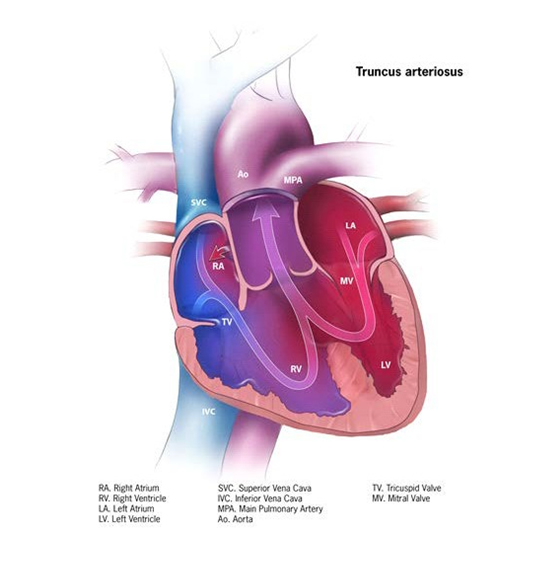4.5b Common Truncus (Q20.0)
‹View Table of Contents
Common truncus or common arterial trunk is a structural heart defect characterized anatomically by having a single common arterial trunk, rather than a separate aorta and main pulmonary artery (see Fig. 4.15). This common trunk carries blood from the heart to the body, lungs and the heart itself – that is, the common trunk gives rise to the systemic, pulmonary and coronary circulation. A ventricular septal defect is present. Other terms for the condition are (persistent) truncus arteriosus.
The anatomy of common truncus varies, especially in the origin of the pulmonary arteries from the common truncus. Such variations are the basis of the two main classifications: the Edwards classification (types I–IV, of which types I–III are properly common truncus) and the van Praagh classification (A1–A4).
Fig. 4.15. Common truncus


Relevant ICD-10 codes
Q20.0 Common arterial trunk
Diagnosis
Prenatal. Common truncus can be diagnosed prenatally by fetal echocardiography, although in some cases it might be difficult to conclusively distinguish from other conditions (e.g. pulmonary atresia with ventricular septal defect or aortic atresia with ventricular septal defect). Common truncus can be missed prenatally if the outflow tract is not fully examined. Prenatal diagnoses should be confirmed postnatally, typically by echocardiography.
Postnatal. The clinical findings after birth depend on the volume of pulmonary blood flow and the status of the truncal valve (e.g. degree of valvar insufficiency). If the valve is severely insufficient, the infant might present early with heart failure, which might be characterized by fast breathing, fast heart rate, poor feeding and excessive sweating. Otherwise, the physiologically high pulmonary vascular resistance at birth will delay this presentation and lead to a degree of cyanosis, usually mild, at the outset.
Newborn screening for critical CHD via pulse oximetry can detect common truncus if sufficient degree of hypoxia is present at the time of screening.
Clinical and epidemiologic notes
As noted, the clinical presentation in the newborn period might include a combination of cyanosis and heart failure.
Common truncus is included among the conotruncal heart anomalies, together with tetralogy of Fallot, interrupted aortic arch type B, and d-transposition of the great arteries. Common truncus can occur in association with genetic conditions – especially deletion 22q11 – and can be familial.
Among modifiable risk factors, maternal pregestational diabetes is common and well established. The birth prevalence of common truncus is approximately is 0.5 to 1 in 10 000 births.
Inclusions
Q20.0 Common truncus
Exclusions
Pulmonary atresia with ventricular septal defect (common truncus type IV in the Edwards classification)
Checklist for high-quality reporting
| Common Truncus – Documentation Checklist |
Describe in detail the clinical and echocardiographic findings:
Look for and document extracardiac birth defects: Common truncus can occur with genetic syndromes such as deletion 22q11, in which many external (e.g. cleft palate) as well as internal anomalies have been described. Report whether specialty consultation(s) have been done: In particular, report whether the diagnosis was done by a paediatric cardiologist, and whether the patient was seen by a geneticist. Report genetic testing (e.g. chromosomal studies, genomic microarray, genomic sequencing): Report whether this was done and if so, the results. |
Suggested data quality indicators
| Category | Suggested Practices and Quality indicators |
| Description and documentation | Review sample of clinical descriptions for documentation of key elements:
|
| Coding |
|
| Clinical classification |
|
| Prevalence |
|
Table of Contents
- Chapter 4: Diagnosing and Coding Congenital Anomalies
- 4.1 List of Selected External and Internal Congenital Anomalies to Consider for Monitoring
- 4.2 Congenital Malformations of the Nervous System: Neural Tube Defects
- 4.2a Anencephaly
- 4.2b Craniorachischisis (Q00.1)
- 4.2c Iniencephaly (Q00.2)
- 4.2d Encephalocele (Q01.0–Q01.83, Q01.9)
- 4.2e Spina Bifida (Q05.0–Q05.9)
- 4.3 Congenital Anomalies of the Nervous System: Microcephaly
- 4.4 Congenital Malformations of the Ear
- 4.5a Overview Congenital Heart D: Prenatal Diagnosis and Postnatal Confirmation
- ›4.5b Common Truncus (Q20.0)
- 4.5c Transposition of Great Arteries (Q20.3)
- 4.5d Tetralogy of Fallot
- 4.5e Pulmonary Valve Atresia (Q22.0)
- 4.5f Tricuspid Valve Atresia (Q22.4)
- 4.5g Hypoplastic Left Heart Syndrome (Q23.4)
- 4.5h Interrupted Aortic Arch (q25.21, Preferred; Also Q25.2, Q25.4)
- 4.6 Orofacial Clefts
- 4.7 Congenital Malformations of the Digestive System
- 4.8 Congenital Malformations of Genital Organs Hypospadias (Q54.0–Q54.9)
- 4.9a Congenital Malformations and Deformations of the Musculoskeletal System: Talipes Equinovarus (Q66.0)
- 4.9b Congenital Malformations and Deformations of the Musculoskeletal System: Limb Reduction Defects/Limb Deficiencies
- 4.9c Limb Deficiency Amelia (Q71.0, Q72.0, Q73.0)
- 4.9d Limb Deficiency: Transverse Terminal (Q71.2, Q71.3, Q71.30, Q72.2, Q72.3, Q72.30)
- 4.9e Limb Deficiency: Transverse Intercalary (Q71.1, Q72.1, Q72.4)
- 4.9f Limb Deficiency: Longitudinal Preaxial (Tibia, Radius, First Ray) (Q71.31, Q71.4, Q72.31, Q72.5)
- 4.9g Limb Deficiency: Longitudinal Postaxial (Fibula, Ulna, Fifth Ray) (Q71.30, Q71.5, Q72.30, Q72.6)
- 4.9h Limb Deficiency: Longitudinal Axial Limb Deficiency – Split Hand and Foot (Q71.6, Q72.7)
- 4.10 Abdominal Wall Defects
- 4.11 Chromosomal Abnormalities